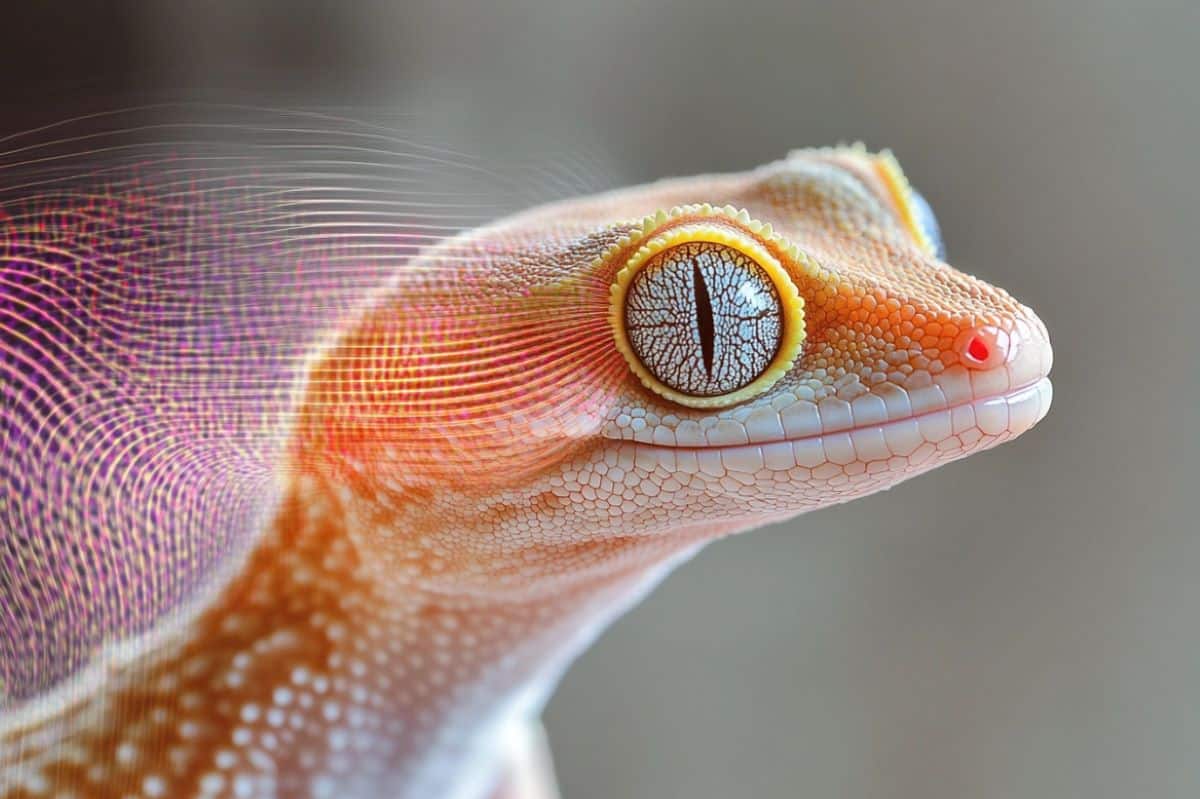Summary: Researchers have discovered that geckos use their saccule, a part of the inner ear associated with balance, to detect low-frequency vibrations. This sensory pathway complements their regular hearing and may be present in other reptiles.
The study reveals that geckos can detect vibrations in the 50-200 Hz range, offering new insights into how sensory systems evolved in animals. This discovery challenges the idea that certain reptiles are “deaf” and opens up possibilities for understanding reptile communication through vibrations.
Key Facts:
- Geckos detect low-frequency vibrations using their inner ear’s saccule.
- This sensory ability may exist in other reptiles previously considered to have limited hearing.
- The study sheds light on how animal sensory systems evolved and adapted over time.
Source: University of Maryland
University of Maryland biologists identified a hidden sensory talent in geckos that’s shaking up what we thought we knew about animal hearing.
In a new study published in Current Biology on October 4, 2024, the researchers revealed that geckos use the saccule—a part of their inner ear traditionally associated with maintaining balance and body positioning—to detect low-frequency vibrations.
According to the researchers, this special “sixth sense” also plays a complementary role to the geckos’ normal hearing and the way they sense the world around them.

The team believes that this previously unrecognized hearing mechanism may be present in other reptilian species as well, challenging existing ideas about how animal sensory systems evolved and diverged over time.
“The ear, as we know it, hears airborne sound. But this ancient inner pathway, which is typically linked to balance, helps geckos detect vibrations that travel through mediums like the ground or water,” said study co-author Catherine Carr, a Distinguished University Professor of Biology at UMD.
“This pathway exists in amphibians and fish, and now it’s proven to be preserved in lizards as well. Our findings shed light on how the auditory system evolved from what you see in fish to what you see in land animals including humans.”
The saccule can detect faint vibrations ranging from 50 and 200 Hz, a spectrum well below what geckos can usually hear through their ears. Researchers say this indicates that the saccule serves a distinct yet complementary function to the geckos’ regular auditory system. While geckos can hear airborne sound, many other reptiles do not have that ability.
The study’s lead author Dawei Han, a postdoctoral researcher and former graduate student at UMD, says that the discovery of the saccule’s role in gecko hearing may lead to a better understanding of communication and behavior in other animals previously considered to have limited auditory capabilities.
“A lot of snakes and lizards were thought to be ‘mute’ or ‘deaf’ in the sense that they do not vocalize sounds or hear sounds well,” Han explained. “But it turns out they could potentially be communicating via vibrational signals using this sensory pathway instead, which really changes the way scientists have thought about animal perception overall.”
The existence of this shared sensory pathway in modern reptiles offers a unique window into the evolutionary history of vertebrate sensory systems, suggesting that the transition from aquatic to terrestrial environments likely involved more complex and gradual changes in hearing mechanisms than previously thought.
Although these findings are not directly connected to how humans hear, the researchers believe that there’s always more than meets the eye—or in this case, ear.
“Think about when you’re at a live rock concert,” Carr said. “It’s so loud that you can feel your whole head and body vibrate in the sound field. You can feel the music, rather than just hearing it. That feeling suggests that the human vestibular system may be stimulated during those loud concerts, meaning our sense of hearing and balance may also be linked closely.”
Carr and Han hope their findings will prompt more investigations into mammalian hearing, especially in the context of this sensory pathway. They believe that the established link between hearing and balance opens up new avenues for research, including the connection between human hearing and balance disorders.
“The implications of this research extend beyond the world of reptiles,” Han said. “As we uncover these hidden mechanisms, we’re also gaining a richer and more nuanced picture of how animals perceive and interact with their environments—and potentially, new insights into our own sensory experiences.”
Funding: This research was supported by the National Institutes of Health (Grant No. R01DC019341).
About this auditory neuroscience research news
Author: Georgia Jiang
Source: University of Maryland
Contact: Georgia Jiang – University of Maryland
Image: The image is credited to Neuroscience News
Original Research: Open access.
“Auditory pathway for detection of vibration in the tokay gecko” by Catherine Carr et al. Current Biology
Abstract
Auditory pathway for detection of vibration in the tokay gecko
Otolithic endorgans such as the saccule were thought to be strictly vestibular in amniotes (reptiles, birds, and mammals), with little evidence supporting the auditory function found in fish and amphibians (frogs and salamanders).
Here, we demonstrate an auditory role for the saccule in the tokay gecko (Gekko gecko).
The nucleus vestibularis ovalis (VeO) in the hindbrain exclusively receives input from the saccule and projects to the auditory midbrain, the torus semicircularis, via an ascending pathway parallel to cochlear pathways. Single-unit recordings show that VeO is exquisitely sensitive to low-frequency vibrations.
Moreover, VeO is present in other lepidosaurs, including snakes and Sphenodon. These findings indicate that the ancestral auditory function of the saccule is likely preserved at least in the lepidosaurian lineage of amniotes and mediates sensitive encoding of vibration.






